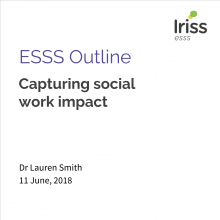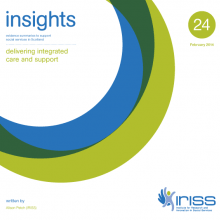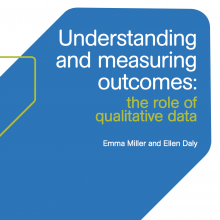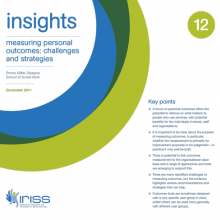Key points
- Recent evaluations of UK-based social prescribing interventions are concerned with schemes that employ link workers or community navigators to signpost participants to community-based activities.
- Referrals to link workers can come from primary care, social services or self-referral.
- The majority of evidence on social prescribing in Scotland comes from the city of Glasgow.
- Most evaluations are non-experimental in design and do not include a control group.
- Interviewing methods are widely and successfully used to capture service user experience and self-reported outcomes.
- The interrogation of data on peoples’ use of healthcare services can help us understand the impact of social prescribing schemes on individuals, and healthcare services.
- The Warwick-Edinburgh Mental Wellbeing Scale (WEMWBS) is a widely used measure that can help to compare the outcomes of different social prescribing schemes.
- The current evidence suggests that social prescribing has the potential to improve both physical and mental wellbeing. However, more research is needed to establish what works, for whom and in what circumstances.
Introduction
Much Scottish health and social care policy is built on a person-centred approach that looks to empower individuals to self-manage or improve their own health and wellbeing (Scottish Government, 2013).
While responses can involve medical management of specific health conditions, increased emphasis has been put on providing non-medical options, with service users gaining access to these through linking services, often referred to as ‘social prescribing’ (LTCAS and Scottish Government, 2008; NHS Health Scotland, 2016).
This Insight provides a review of the research methods and approaches used to evaluate UK-based social prescribing interventions in recent years, to inform healthcare and social services professionals, as well as organisations delivering social prescribing interventions and those conducting evaluations of them. It aims to give an overview of how social prescribing has been evaluated, and, importantly, what can be learned from this.
Social prescribing and context
The Scottish Government established the Christie Commission in 2010. The resulting recommendations (2011) emphasised the need to empower communities to achieve a more joined-up and community-oriented approach to health and social care that is both preventative and person-centred. This was in response to a complex context in which public budgets were reduced, and demand high, driven by an ageing population and health inequalities (Christie Commission, 2011).
Social prescribing fits well within the ethos of Scottish health and social care policy, which calls for increased integration of services to ensure they are received when and where they are most needed (NHS Scotland, 2019). Social prescribing has often been defined in Scottish policy context as: ‘an approach (or range of approaches) for connecting people to non-medical sources of support or resources in the community which are likely to help with the health problems they are experiencing’ (NHS Health Scotland, 2016, p4). However, social prescribing can act on more than physical health ‘problems’ and has the potential to assist with issues such as social isolation, low self-esteem or mental health. In line with the self-management strategy for long term conditions in Scotland (LTCAS and Scottish Government, 2008), the aim is to support self-management in partnership with the beneficiary of the service.
Service users may be referred to a range of resources, including, but not limited to, the arts, physical activity, green space, cultural activities, and different forms of advice and support. Health and social care workers, as well as those employed by social services, can act as referrers to social prescribing schemes. Referrals do not only come from primary care workers such as GPs and community nurses, but also from the wider social services workforce, ‘including social workers, people working in residential and day care services for adults and children, care at home and housing support staff, occupational therapy staff, mental health officers, people working in adult and child protection and in criminal justice services’ (Social Work Services Strategic Forum, 2015, p12).
A health and social care, or social services, professional thus refers the service user to an intermediary called a ‘link worker’ (or similar), who then works with them to find appropriate local opportunities, such as exercise or arts classes, to improve health and wellbeing. In some instances, a healthcare professional or social worker may refer service users directly to the provider of activities, such as a voluntary group. In December 2019, the Scottish Government reported that it remained on track to deliver on its commitment of 250 community link workers in GP surgeries by 2021 (NHS Scotland, 2019), thus rolling out the service across Scotland.
There are various models of social prescribing in use. Services can range from ‘simple’ signposting, to a more holistic model, where individuals engage with the link worker meaningfully over time, building relationships and actively engaging in decision-making regarding their own wellbeing. This type of social prescribing is most meaningfully aligned with current principles of asset-based approaches and co-production in health and wellbeing (Paterson, 2019).
Furthermore, Scottish policy relating to the arts, sport, education and community sectors is increasingly cognisant of the role of these types of community services in supporting health and wellbeing (Scottish Government, 2020; Scottish Government, 2018; Scottish Government, 2012). However, explicit social prescribing policy within Scotland is very much situated within discourses of health and healthcare, despite its wider relevance. A policy such as self-directed support for example (Scottish Government, 2019), designed to provide people with choice and control over how their social care needs are met, is congruent with the empowerment social prescribing often strives to achieve. Furthermore, social work practices, such as social pedagogy, provide an approach that focuses on social welfare and both individual and societal change through education, viewed as a social process (Smith and Monteaux, 2019). Within this broad context, it is unsurprising that there has been an increased political interest in social prescribing. In 2015, the Scottish Parliament Equal Opportunities Committee recommended an investment in learning from and sharing good practice about social prescribing. More recently, the Health and Sport Committee of the Scottish Parliament (2019) launched an inquiry into social prescribing, seeking views on: its suitability as an alternative to medicinal prescribing; whether it can lead to sustained participation in sports; who should decide when it is the most appropriate approach; barriers to social prescribing; and how to best monitor and evaluate effectiveness of social prescribing.
Scoping the evidence
A review of peer reviewed and grey literature was conducted relating to the evaluation of social prescribing interventions in the UK over the last ten years (2009–19). A systematic search strategy was developed to identify UK-based, non-pharmaceutical interventions, which featured an element of ‘social prescription’, a stated health or wellbeing aim, and which had been evaluated and published from 2009 onwards. This approach was chosen in order to provide an overview of research that captures the broad range of activities social prescribing encompasses. This includes arts, physical activity and other activities aimed at improving the wellbeing of service users in a holistic manner. An understanding of the methodologies used to evaluate social prescribing schemes was also sought, as informative to developing the evidence base. Therefore, the authors agreed to exclude systematic and other evidence reviews from this paper, instead focussing on individual programme evaluations.
A Boolean search involving a combination of intervention and health keywords was used to explore the academic literature in the databases Scopus and PubMed and grey literature through Google, with this search restricted to the first three pages of results.
Intervention keywords: (‘social prescribing’ OR ‘social prescription’ OR ‘community navigator’ OR ‘link worker’) AND (‘evaluation’ OR ‘intervention’ OR ‘trial’ OR ‘project’ OR ‘programme’ OR ‘initiative’ OR ‘scheme’)
Health keywords: AND (‘health’ OR ‘wellbeing’ OR ‘mental health’)
To be included in the review, an intervention had to meet the inclusion criteria for ‘social prescription’, and thus contain an element referred to as ‘social prescribing’ and/or a ‘link worker’ or ‘community navigator’. The intervention also had to be UK-based, evaluated, and published between 2009 and 2019.
This yielded a total of 29 evaluations of social prescribing interventions meeting our inclusion criteria, with duplicates retained in the Scopus results, and removed from the PubMed and Google results.
Characteristics of social prescribing schemes
Of the 29 evaluations included in the review, the majority related to general social prescribing schemes/initiatives/programmes (69%) or social prescribing pilots (31%) that involved:
- Referral by a health or social care professional directly to an activity such as the arts (21%)
- Referral to a link worker or similar (79%)
Almost half of the schemes evaluated (41%) were targeted at people experiencing either social isolation, loneliness or both. The majority (59%) cited that they were targeting people who either had frequent primary or secondary healthcare presentations, or had presented with some form of non-clinical need, such as support for self-management.
Just over half of the evaluations (52%) stated they were targeting people with one or more long-term conditions. A total of 41% of the schemes involved the production of a personalised Wellbeing Plan, co-produced with service users to help them achieve their goals.
Of those schemes that specifically mentioned a target age group, most were for those over 18, although some were for older people. Most of the schemes evaluated were England-specific (83%) and, of those, almost 30% were from Greater London. In the Scottish context, four evaluations met our inclusion criteria, of which three were in Glasgow.
Evaluation approaches and methods
This section outlines the various methods and approaches used in the social prescribing evaluation literature reviewed. The vast majority of the evaluations (97%) – all except Panagioti and colleagues (2018) – were non-experimental in design, which meant that a control group was not assigned as a comparator. This is a weakness within the evaluation literature in terms of assessing the efficacy of social prescribing. Thus, most evaluations determine the benefits to users of the service, without comparison to treatment that would have been received regardless, or consideration of those who ‘drop out’ or decline to take part.
The methodology closest to a controlled study was that used by Panagioti and colleagues (2018). It included a control group assigned using a ‘Trials within Cohorts’ (TWiCs) design. TwiCs resemble more closely how treatment decision-making is carried out within routine care than a conventional randomised control trial.
Overall, most of the papers (62%) were focused on outcomes evaluation, of which two included economic analysis: an assessment of the economic and environmental costs of a social prescribing service in Maughan and colleagues (2016), and economic and social cost-based analysis in Dayson and Bashir (2014).
Some of the evaluations considered process (21%), which assesses the development and implementation of an intervention, highlighting what has worked well and what has not. Undertaking more process evaluations would help inform the development, and potentially the success, of social prescribing interventions. One process evaluation included an analysis of cost and potential savings (Bertotti and colleagues, 2015).
Of the evaluations we reviewed, 17% were formative in nature and, therefore, had been designed to continually assess the impact of the intervention during its lifetime and offer ongoing information to inform future delivery.
The most commonly used data collection method was interviewing (76%). This is an appropriate method to use in order to understand individuals’ experiences of taking part in a social prescribing programme. Twelve evaluations (41%) combined qualitative interviewing with some type of quantitative measure. The most common quantitative indicators are ranking types of physical and mental health measures such as WEMWBS and/or healthcare service usage data. Validated health measures were used by ten evaluations (34%).
Twenty-one (72%) of the reviewed evaluations included some form of before and after measurement – this helped to understand changes that may be brought about by the social prescribing interventions. There was great variability in the length of time between baseline measurement and follow-up within the evaluations, ranging from two weeks to two years.
Evidence of impact and supporting factors
The type of evidence used the most was self-reported changes in physical and mental health. This was captured either through qualitative analysis of interviews or focus groups, or through participant completion of questionnaires. The data collected reported on improvements, for example, in levels of social isolation, loneliness, self-esteem and / or overall level of wellbeing.
The evaluations that used WEMWBS as a validated wellbeing measure showed that scores for wellbeing increased over time following participation in social prescribing. Some evaluations noted that there were a minority of participants within their sample for whom levels of physical or mental health did not increase. Unfortunately, there is little examination of why this was the case, and what might have made a difference to these individuals. It may be, for example, that health deterioration occurred for reasons unconnected to participation in social prescribing activities.
Another example of measurement of psychological wellbeing came from Thomson and colleagues (2018) who, through use of the Museum Wellbeing Measure for Older Adults (MWM-OA), demonstrated wellbeing improvements resulting from museum-based group activities for older adults. However, the evaluation focused on the activity at hand, rather than the value of a link worker, or similar, social prescription services in general. This evaluation demonstrates the value of using bespoke, context appropriate, measures to quantify changes in wellbeing. However, it means comparison with the results of other evaluations is not possible.
Not all studies were able to demonstrate that social prescribing resulted in positive wellbeing outcomes. The trials within cohorts study by Panagioti and colleagues (2018) found no statistical difference in wellbeing outcomes of those selected for the intervention, and those who did not take part. This suggests that the inclusion of comparator or control groups may be beneficial in future evaluations.
In addition to wellbeing measures, some of the interventions in the review aimed to increase physical activity. Evaluations generally report that interaction with a link worker or community navigator leads to increases in participants’ physical activity levels. Qualitative evidence also suggests that some people feel more capable of self-managing their conditions following participation in a social prescribing scheme.
Where healthcare attendance data had been collected and examined, reductions in use following a social prescription referral were reported for primary, secondary and emergency health care. Dayson and Bashir (2014), for example, found that referral to social prescribing resulted in reduced use of hospital resources. Panagioti and colleagues (2018) also found that emergency care use was lower for those taking part in the social prescribing intervention, although the use of planned services was higher. However, Loftus and colleagues (2017) reported no statistically significant change in GP contacts or repeat prescriptions following participation in social prescribing. Maughan and colleagues (2016) highlighted a trend towards lower healthcare service use following participation in social prescribing, but also noted that this was not statistically significant.
In summary, most of the evaluations reviewed were primarily concerned with outcomes measurement for participants, albeit some recognise the importance of context and other factors. Pescheny and colleagues (2019, p8), for example, state that: ‘navigators appear to be a key component of the social prescribing pathway and may partly explain how and why social prescribing interventions work’. This is a sentiment echoed by Wildman and colleagues (2019, p1) who note: ‘the importance of a strong and supportive relationship with an easily-accessible link worker’.
Recommendations for evaluating social prescribing
In summary, the evidence base on the effectiveness of social prescribing is variable in nature, generally owing to differing and largely qualitative outcome measures, with no use of control groups. However, the evidence available does suggest that it can have positive outcomes for individuals in terms of wellbeing, physical activity, mental health and loneliness. Therefore, referral of clients from social services to link workers or similar, may act positively on individuals’ general wellbeing. However, further evaluation and collection of evidence is required to be able to make any more specific conclusions on what might work for whom. This review suggests that benefit may be released by ensuring that social prescribing services have inward referral routes from social services, not only primary health care.
In terms of scale, we identified only 29 evaluation studies meeting our criteria. Most Scottish studies were from Glasgow and most English studies from London, with most relatively small in scale. The review reveals the limitations and gaps in the available evidence, and the need for more and stronger evidence to support further investment in social prescribing. There is also a need for future evaluations to be larger in scale and provide evidence on different geographical contexts. There may be the potential to combine data from different pilot schemes and NHS board areas in order to provide a larger dataset for analysis.
The vast majority of the evaluations were non-experimental in design; future evaluations could benefit from the inclusion of a control group. However, the evaluations included show that qualitative methods are appropriate for capturing participant experience of taking part in a social prescribing programme, as well as self-reported outcomes. WEMWBS is a widely used measure to assess changes in wellbeing, and its continued use may help practitioners and healthcare services managers to compare the impact of their local and regional schemes with those of other areas.
Also, while most of the evaluated social prescribing schemes included a link worker, there is little consideration of this role within the generation of positive outcomes for participants. Where this is considered, evaluators find the link worker plays an important role in the generation of outcomes. However, qualitative studies tend to focus on service user perspectives, not link workers. The role of the link worker – and the context in which they work – warrants closer examination and understanding. As link workers are rolled out to primary healthcare settings in Scotland, it will be important to establish clear routes of referral to them from social services, and an awareness of how these two sectors can work effectively together.
There is an opportunity for future evaluations to use a variety of research methods to provide robust, but also rich, data to tease out the mechanisms and conditions that deliver real impact within this complex intervention. It is, however, important to be sensitive to the impact of data collection on the relationship between the service user and link worker, and ensure that data collection doesn’t become too onerous for either.
The studies included in this review also demonstrate the utility of including data on use of health services, which supports an understanding of the impact of social prescribing on levels of attendance in primary, secondary and emergency health care. No studies were found to include use of social services, which may be an area for future research.
Going forward, it will be important for health and social services practitioners to consider what an evaluation of a social prescription scheme might look like from the outset.
In relation to social prescribing, a greater number of studies from a wider range of geographical contexts – involving relevant practitioners and using mixed methods – can help build the evidence base for what works, for whom and in what context.
References
- Bertotti M, Frostick C, Findlay G et al (2015) Shine 2014 final report - Social prescribing: integrating GP and community assets for health . London: The Health Foundation.
- Bertotti M, Frostick C, Hutt P et al (2018) A realist evaluation of social prescribing: an exploration into the context and mechanisms underpinning a pathway linking primary care with the voluntary sector . Primary Health Care Research and Development, 19, 3, 232-245.
- Blickem C, Kennedy A, Jariwala P et al (2014) Aligning everyday life priorities with people's self-management support networks: an exploration of the work and implementation of a needs-led telephone support system . BMC Health Services Research, 14, 262, 1-12.
- Carnes D, Sohanpal R, Frostick C et al (2017) The impact of a social prescribing service on patients in primary care: a mixed methods evaluation . BMC Health Services Research, 17, 835.
- Christie Commission (2011) Report on the future delivery of public services , Edinburgh.
- Chrysalis Research UK Ltd (2018) Social prescribing pilot evaluation - final report - research report for Richmond CCG . East Sussex: Chrysalis Research UK Ltd.
- Dayson C and Bashir N (2014) The social and economic impact of the Rotherham social prescribing pilot: main evaluation report . Sheffield: Centre for Regional Economic and Social Research.
- Dayson C and Bennett E (2016) Evaluation of the Rotherham mental health social prescribing pilot . Sheffield: Centre for Regional Economic and Social Research.
- Dayson C, Bashir N, Bennett E et al (2016) The Rotherham social prescribing service for people with long-term health conditions: annual evaluation report . Sheffield: Centre for Regional Economic and Social Research.
- Equal Opportunities Committee (2015) Age and social isolation. Edinburgh: The Scottish Parliament, SP Paper 816, 5th report.
- Ferguson K and Hogarth S (2018) Social prescribing in Tower Hamlets: evaluation of borough-wide roll-out . London: Tower Hamlets Together.
- Hanlon P, Gray CM, Chng NR et al (2019) Does self-determination theory help explain the impact of social prescribing? A qualitative analysis of patients' experiences of the Glasgow 'Deep-End' Community Links Worker Intervention . Chronic Illness, 0, 1-16.
- Healthy Dialogues Ltd (2018) Evaluation of the East Merton social prescribing pilot .
- Kimberlee R (2016) Gloucestershire clinical commissioning group’s social prescribing service: evaluation report .
- LTCAS (Long Term Conditions Alliance Scotland network) and Scottish Government (2008) Gaun Yersel! The self management strategy for long term conditions in Scotland .
- Loftus AM, McCauley F and McCarron MO (2017) Impact of social prescribing on general practice workload and polypharmacy . Public Health, 148, 96-101.
- Maughan DL, Patel A, Parveen T et al (2016) Primary-care based social prescribing for mental health: an analysis of financial and environmental sustainability . Primary Health Care Research and Development, 17, 2, 114-121.
- Moffatt S, Steer M, Lawson S et al (2017) Link worker social prescribing to improve health and well-being for people with long-term conditions: qualitative study of service user perceptions . BMJ Open, 7, 7.
- NHS Health Scotland (2016) Social prescribing for mental health: guidance paper. Edinburgh: NHS Health Scotland
- NHS Scotland (2019) An integrated health and social care workforce plan for Scotland. Edinburgh: The Scottish Government
- Panagioti M, Reeves D, Meacock R et al (2018) Is telephone health coaching a useful population health strategy for supporting older people with multimorbidity? An evaluation of reach, effectiveness and cost-effectiveness using a ‘trial within a cohort’ . BMC Medicine, 16, 80.
- Paterson, A (2019) Redefining the model. An introduction to social prescribing .
- Pescheny J, Randhawa G and Pappas Y (2018) Patient uptake and adherence to social prescribing: a qualitative study . BJGP Open, 2, 3.
- Pescheny JV, Gunn LH, Randhawa G et al (2019) The impact of the Luton social prescribing programme on energy expenditure: a quantitative before-and-after study . BMJ Open, 9, 6.
- Redmond M, Sumner RC, Crone DM et al (2019) 'Light in dark places': exploring qualitative data from a longitudinal study using creative arts as a form of social prescribing . Arts and Health, 11, 3, 232-245.
- Scottish Government (2020) A Culture Strategy for Scotland .
- Scottish Government (2019) Social care support - An investment in Scotland’s people, society, and economy. Self-directed support implementation plan 2019 – 2020 .
- Scottish Government (2018) A more active Scotland: Scotland’s physical activity delivery plan .
- Scottish Government (2013) Route map to the 2020 vision for health and social care .
- Scottish Government (2012) Strategic guidance for community planning partnerships: community learning and development.
- Scottish Parliament (2019) Social prescribing of physical activity and sport .
- Skivington K, Smith M, Chng NR et al (2018) Delivering a primary care-based social prescribing initiative: a qualitative study of the benefits and challenges . British Journal of General Practice, 68, 672.
- Smith M and Monteux S (2019) Social pedagogy and its relevance for Scottish social welfare. Iriss Insight 49 .
- Snowden A, Young J and Savinc J (2018) Proactive community support tailored to holistic needs: A cohort study . Cancer Medicine, 7, 9, 4836-4845.
- Social Work Services Strategic Forum (2015) Social services in Scotland: a shared vision and strategy 2015 – 2020
- Stickley T and Eades M (2013) Arts on prescription: a qualitative outcomes study . Public Health, 127, 8, 727-734.
- Stickley T and Hui A (2012) Social prescribing through arts on prescription in a UK city: participants' perspectives (Part 1) . Public Health, 126, 7, 574-579.
- Thomson LJ, Lockyer B, Camic PM et al (2018) Effects of a museum-based social prescription intervention on quantitative measures of psychological wellbeing in older adults . Perspectives in Public Health, 138, 1, 28-38.
- Vassilev I, Rogers A, Kennedy A et al (2019) Identifying the processes of change and engagement from using a social network intervention for people with long‐term conditions. A qualitative study . Health Expectations, 22, 2, 173-182.
- Vogelpoel N and Jarrold K (2014) Social prescription and the role of participatory arts programmes for older people with sensory impairments . Journal of Integrated Care, 22, 2, 39-50.
- Whitelaw S, Thirlwall C, Morrison A et al (2017) Developing and implementing a social prescribing initiative in primary care: insights into the possibility of normalisation and sustainability from a UK case study . Primary Health Care Research and Development, 18, 2, 112-121.
- Wildman JM, Moffatt S, Steer M et al (2019) Service-users' perspectives of link worker social prescribing: a qualitative follow-up study . BMC Public Health, 19, 98.
- Woodall J, Trigwell J, Bunyan A et al (2018) Understanding the effectiveness and mechanisms of a social prescribing service: a mixed method analysis . BMC Health Services Research, 18, 604.
Acknowledgements
This Insight was reviewed by Eona Craig (Articulate Cultural Trust), Susan Levy (University of Dundee), Kristi Long (NHS Education Scotland), Kayleigh Stockley and Jeff Macdonald (ALLIANCE). Comments represent the views of reviewers and do not necessarily represent those of their organisations. Iriss would like to thank the reviewers for taking the time to reflect and comment on this publication.






